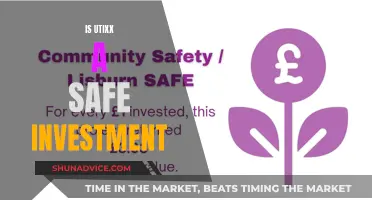
The sharks on the TV show Shark Tank are investors who decide whether to back fledgling companies with their own money in exchange for a stake in the business. Sharks make their decisions based on a variety of factors, including revenue, earnings, and the value of companies within the same sector. They also consider the entrepreneur's pitch and ask questions about costs and manufacturing to calculate the product margin. Sharks will also consider intangibles, such as brand recognition, patents, and intellectual property. Ultimately, the sharks want to get their investment back and make a profit, so they carefully weigh the risks and rewards of each opportunity.
What You'll Learn

Cost of investment vs value
When deciding whether to invest in a business, the "sharks" on *Shark Tank* consider the cost of investment versus the value. The cost of investment is the dollar amount at which the sharks decide to invest in a business. The value is what the sharks get in return for their investment.
The sharks on *Shark Tank* are investors with high-level connections and resources that can help a company grow. In return for giving up a stake in the company, the entrepreneur gets funding, but more importantly, they get access to the Sharks, their network of contacts, their suppliers, and their experience.
The sharks typically require a stake in the business—or a percentage of ownership—and a share of the profits. The amount of money the entrepreneur is asking for, combined with the percentage of equity they are offering, represents the value of the company. For example, if an entrepreneur asks for $100,000 with 10% equity, the sharks know that $100,000 is 10% of the company's valuation, which in this case is $1 million.
The sharks will also consider the company's revenue, profit margins, and growth trajectory. They will ask how much the company made in the previous year and divide the valuation by that amount. If the company made $100,000 last year, it would take ten years for an investor to break even on a $1 million valuation. However, investors like the sharks are looking for companies that will make significantly more in the next few years.
The sharks will also consider a company's current momentum. For example, a company with a $1 million valuation that made $200,000 the previous year and recently went viral on social media is likely to attract the sharks, who may fight over the startup by offering more money at the same percentage of equity or for less equity.
The sharks will also consider the business model and revenue streams. Subscription-based business models, for instance, often attract higher valuations due to their potential for recurring revenue. Diversified revenue streams, such as those from multiple products, can also be a positive indicator of high revenue potential, suggesting stability and multiple avenues for long-term growth.
Market size and growth potential are also important factors in the sharks' valuation calculations. A business operating in a large, rapidly growing market is generally more attractive to investors. The sharks look for indications that the market is substantial and expanding, offering ample room for the business to grow and capture more market share over time. They evaluate industry trends, customer demand, and potential market penetration.
The cost of investment versus value is a critical factor in the sharks' decision-making process. By considering the value they are getting for the cost of their investment, the sharks can make informed decisions about whether to invest in a particular business.
Apple's India Investment: What's the Deal?
You may want to see also

Potential income
When deciding whether to invest in a business, one of the most important considerations for the Sharks on ABC's Shark Tank is the potential income. They want to ensure that any investment they make will be profitable and worth their time and money.
The Sharks are interested in the business's revenue and earnings. They will ask about the previous year's sales and any sales in the pipeline to estimate future demand for the product or service. They will also inquire about the costs of producing the goods or services, including manufacturing, marketing, research and development, and salaries or wages, to understand how much revenue the business retains as profit.
The Sharks use this information to calculate an earnings multiple, which is the company's profit compared to its valuation from sales revenue. For example, if a company is valued at $1 million and the owner earns $100,000 in profit, the earnings multiple would be 10. However, this number alone may not provide enough context, so the Sharks may also use a comparable company analysis to see how the earnings multiple stacks up against similar companies in the same industry.
The potential income of an investment is crucial for the Sharks, as they want to ensure that the opportunity presents a better prospect than what they could earn through other investments. They are looking for deals that will provide a substantial return on their investment and are willing to take on the risk of investing in startups or small businesses because of the potential for high rewards.
To make their final decision, the Sharks will consider the forecasted revenue and earnings of the business and apply a valuation to determine the amount they are willing to invest and the percentage of ownership they are seeking. They will also take into account the entrepreneur's pitch, their experience, and any intangible assets, such as brand recognition, patents, or intellectual property.
Trump's Impact: Forcing Ford and GM's US Investment
You may want to see also

Simplicity of the pitch
Sharks are investors who appear on the TV show Shark Tank. They are pitched to by entrepreneurs seeking investment in their business. The sharks are often experienced investors, and they make decisions on whether to invest based on a few key factors.
The simplicity of the pitch is important to the sharks. They expect to be able to understand the business and how it will make money within a couple of minutes. They will ask questions to get to the basic idea of the business and its investment potential. If the pitch is too complex, they may decide to pass on the opportunity. A simple pitch helps the sharks remember why they decided to invest and makes it easier for them to stay invested for the long run.
The sharks will also want to know the value of the investment opportunity and what they will get for their money. They will compare the potential income to what they could earn with other investments. They will also consider the costs involved and whether there are better-value investment opportunities elsewhere.
The sharks will also consider the intangibles, such as the entrepreneur's experience, brand quality, and any intellectual property or patents the business might have. They will also look at the bigger picture, including the entrepreneur's story and experience, when valuing the business.
Overall, the sharks on Shark Tank make decisions on what to invest in based on a few key factors, including the simplicity of the pitch, the value of the investment, and the intangibles. A clear and concise pitch that highlights the business's potential and unique qualities is more likely to result in an investment from the sharks.
Protecting Your Reputation: A Smart Investment Strategy
You may want to see also

Intangible value
Sharks on shows like Shark Tank understand that the world has moved on from the days of railroads and steel mills. They know that intangible assets are now key to a company's success. When deciding whether to invest, they consider the following:
- Simplicity: Sharks prefer investments that are easy to understand. They want to know how the investment will make them money and whether it will be simple to stay invested for the long run.
- Potential Income: Sharks often turn down opportunities if the potential income is less than what they could earn elsewhere. They want to know that the investment will provide a good return compared to other options.
- Cost: Sharks consider the dollar amount of the investment and what value they are getting in return. They weigh this against other investment opportunities to ensure they are getting the best value for their money.
When evaluating intangible value, it is essential to consider the following:
- Low Transparency: Intangible accounting items often lack transparency, making it challenging to evaluate them accurately.
- Omission from Balance Sheets: Intangible assets like brand equity and network effects are often not recorded on balance sheets, leading to distorted valuation metrics.
- Organic vs. External Growth: Companies with a history of organic growth may have higher P/B and P/E ratios than those with a serial M&A activity, even if they generate identical cash flows.
- Capitalizing Intangibles: Treating intangible assets like tangible assets can be challenging due to their unique characteristics, such as uncertainty and scalability.
- R&D Expenses: Investments in research and development can have highly variable outcomes, making it difficult to determine their value.
By considering these factors and adapting to the evolving nature of the economy, investors can make more informed decisions and identify valuable investments that others may overlook.
Equity Investing: Quantitative Strategies for Stock Market Success
You may want to see also

Risk-adjusted discounting
The time value of money refers to the idea that money in the future is worth less than money today as it has less earning capacity. This is an important principle of finance, reflecting that money can earn interest over time. Therefore, the discount rate used to evaluate an investment must account for the time horizon of the investment, with future cash flows being discounted to their present value.
The risk-adjusted discount rate also takes into account the level of risk associated with an investment or project. The greater the perceived risk, the higher the discount rate adjustment. This reflects the relationship between risk and return, where investors who are willing to take on more risk will expect higher returns to compensate for the possibility of greater losses.
There are several types of risks that can impact the discount rate, including the timing, dollar amount, and duration of cash flows. For long-term projects, there is also uncertainty relating to future market conditions, profitability, and inflation levels. Other risks to consider are the liquidity of the company, the risk of default by other parties, currency risk, and the potential for damage to a company's reputation or regulatory issues.
The risk-adjusted discount rate is calculated by taking the risk-free rate and adding a risk premium based on the perceived level of risk. While this approach is reasonably straightforward, it can be challenging to determine an appropriate risk premium. Additionally, it assumes that investors are risk-averse, which may not always be the case as some investors are willing to accept high levels of risk for the potential of large payoffs.
When deciding on investments, investors can use the risk-adjusted discount rate to compare the expected returns of different opportunities and choose those that align with their risk tolerance and investment goals. This allows them to make informed decisions and balance their portfolio to generate returns from multiple sources of risk.
In summary, risk-adjusted discounting is a valuable tool for investors, providing a quantitative approach to assess the profitability of investments while accounting for the time value of money and the level of risk involved.
Strategies for Adding Investment Management to Your Portfolio
You may want to see also
Frequently asked questions
Sharks decide which companies to invest in based on the business's valuation and their forecast of its revenue and earnings. They also take into account the company's sales pipeline, the cost to produce goods or services, and other costs such as marketing, research and development, and salaries. Sharks ultimately want to make a profit on their investment, so they consider the potential income and compare it to what they could earn elsewhere.
An important factor is the simplicity of the investment concept. Sharks on Shark Tank prefer pitches that are relatively easy to understand, as this indicates a lower level of complexity and risk. Additionally, they consider the entrepreneur's experience, access to retail outlets, and supply chains, as well as the company's brand, patents, and intellectual property.
Sharks are cautious about investing in companies with high valuations that might not be supported by the company's financial performance. They also pay attention to the growth rate, failure and liquidity risks, and the potential for the entrepreneur to bypass them when it comes to profit distribution. Sharks are also less likely to invest if the investment concept is too complex or difficult to understand.







